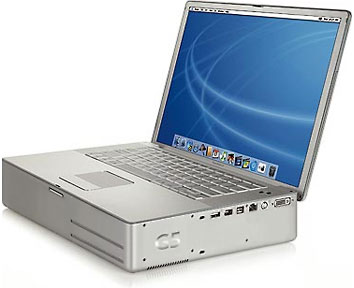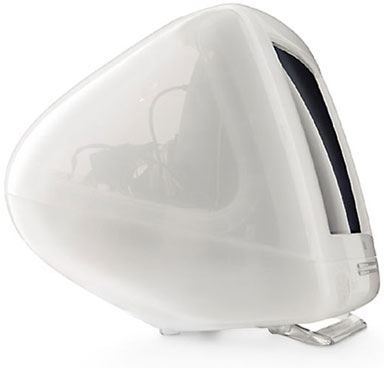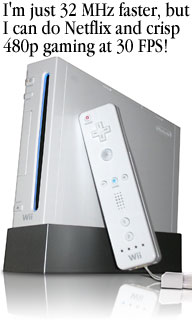Apple, Tech, and Gaming
Xbox 360 and PS3: A PowerPC G5 Saga
- 2012.08.27 - Tip Jar
A question that eludes many in the circles of gaming everywhere is one that has a lot to do with Apple and its relationship that crumbled with IBM, which signaled the end of the PowerPC era: What does the PowerPC G5 have to do with Sony and Microsoft?
The answer to that is a lot more than meets they eye, but before I get into that, here's a bit of a back story on that - and why there was never a PowerBook G5 and why the G5 was abandoned so quickly in favor of Intel.
PowerPC G5 a 'Thermal Nightmare'

Power Mac G5 cooling system.
Steve Jobs and Co. went to IBM, which supplied the PowerPC chips in the Power Mac G5, and asked IBM to provide a mobile G5 in the early going (sometime around late 2002 to early 2003 when the desktop versions were getting ready to ship). Apple engineers had called G5 chips a "thermal nightmare" and knew that it was going to be difficult (if not impossible) to bring a PowerBook G5 to the market alongside Apple's G5 desktops.1 No one at IBM seemed to be able to give Apple the answers it wanted, and the rest is history, as they say.

G5 PowerBook that never was.
Apple engineers figured out how to cope with the G5 in a desktop setting through an array of complex fan placements in air cooled cases and with notorious liquid cooling systems that were prone to failure in later models, such as the dual-core and quad-core Late 2005 units. As time wore on, the technology was never miniaturized to make a PowerBook G5, and IBM had also promised 3 GHz G5 processors for desktops and did not deliver. IBM kept promising faster, cooler, more efficient processors, but ultimately it just couldn't get Apple what it needed, and the die was cast well in advance for Intel to take over in a plot we know all too well.
By mid to late 2004, Apple had already begun development on it's next OS (Mac OS X 10.4 Tiger with an extra hidden x86 binary, which drew some red flags at IBM, but Apple played it off as experimental). We all know about the big bomb dropped in June 2005 at WWDC, not even two months after the April 2005 release of Tiger - the unthinkable decision of Apple publicly announcing the end of the PowerPC architecture in favor of transitioning to Intel x86 for its 2006 machines. The writing was on the wall, and sadly it was something that had to be done. With one fell swoop ended the names iBook, PowerBook, and Power Mac, upsetting many Apple purists with a harsh ushering in of the MacBook, MacBook Pro, and Mac Pro era we live in today.
PowerPC in Gaming Consoles
How does all that relate to PlayStation 3 and Xbox 360 development?

Sony Playstation 3
This is what surprises me the most, given the obvious fact that the PowerPC 970 processors ran so hot and couldn't be tamed by IBM and Apple engineers for mobile usage, which is also the kind of tight quarters that a game console provides. Sony and Microsoft decided on processor cores for their current generation consoles based on these very PowerPC 970 processors. No wonder why there are so many thermal issues with the PS3 and Xbox 360 causing "Yellow Light of Death" and "Red Ring of Death" syndromes (demanding graphics, optical drives, tight space, and heavy hitting power supplies didn't help matters much either).

Microsoft Xbox 360
For those not familiar, the Yellow Light of Death (YLOD) is a blinking yellow light on the PS3 console that is usually preceded by your console freezing up and succeeded by a blinking red status light meaning that your console is toast, kaput, finished, and will need repaired. The Red Ring of Death (RROD) on the Xbox is given by a red status light on the front of the console indicated in four quadrants. Once those four quadrants are lit, game over - time for Red Ring of Death repair.
These issues on both consoles are almost always due to overheating and solder becoming weak between the GPU board and the main board. Beware of shoddy repair attempt methods seen in YouTube videos using a hair dryer to reflow the GPU. This will not give you a long-term fix and could cause permanent damage to your console. A future article will give better advice on how to remedy these problems without potentially causing permanent damage to your console.
Here is the rundown on the two different, but somewhat similar, processor sets for the PS3 and Xbox 360:
The PS3 uses a custom developed IBM 7-core Cell processor array (with one of the cores dedicated to the RSX GPU set). The Xbox 360 uses an IBM "Xenon" set of three dual-core processors with hyperthreading for a total of six virtual cores. They are essentially the same in overall CPU power, but the extra dedicated cores to the GPU give the PS3 a bit more graphics punch. Needless to say, both systems used PowerPC-based processors developed at the tail end of the PowerPC 970, combined with a need to push out hard-hitting high definition visuals, which puts a lot of strain on the processors and GPU.
A big shocker is that the Microsoft Xbox Xenon processors are extremely similar to Apple's G5 - they are essentially the same PowerPC 970 dual-core G5 processors used in the Late 2005 G5 Power Macs that have been tweaked a bit and slimmed down. Dev kits were indeed seen running on Power Mac G5s - a stunner considering Microsoft's long association with the Wintel world.2
Here's the million dollar question: If Apple knew that the G5 was a thermal nightmare, why didn't Sony and Microsoft look to Intel in the first place, as they are now (both seem to be locked on to Intel hardware for their next generation entries)? I have three theories:
- Apple made the deal with Intel first and tied up incredible amounts of Intel's production resources to develop all new Macs using x86 processors/logic boards, forcing Sony/Microsoft to stick with IBM, since Intel couldn't meet the demand for all three vendors.
- Because Nintendo and Sony already had a good relationship with IBM, and IBM didn't want to lose even more business, IBM agreed to develop the guts of both the PS3 and Xbox 360 for much cheaper than they could have gotten from Intel.
- Due to the insistence of backward compatibility (given that the Playstation 2 was IBM-based as well with the custom Emotion Engine), it was easy to include that hardware for the launch units (20 GB - CECHB01, 60 GB - CECHA01) and emulate it shortly after with the 80 GB CECHE01 units. The subject of backwards compatibility for Microsoft really bugged a lot of people at first, since they were clearly at a disadvantage for flip-flopping and going to IBM as well. The original Xbox was basically a 733 MHz Pentium III with an Intel motherboard. Had Microsoft stuck with Intel, one could imagine how seamless compatibility with original Xbox games would have been on the 360.
Why Skip G4 Processors?
The PowerPC G4 doesn't have enough oomph to handle demanding HD gaming at 720p or 1080i/1080p, not even in fast dual processor configurations. To handle Blu-ray and 1080p .mkv video, a quad-core G5 with a top of the line GPU barely makes the cut, and this is likely why 6 and 7 cores were needed for the Xbox and PlayStation 3 respectively. Current generation consoles just need more power to handle the things they do.

700 MHz Snow White iMac G3

Nintendo Wii
That said, in the Nintendo GameCube and even the Wii (another current generation console - although about to be displaced by the Wii U), it's surprising that G4 type processors with AltiVec weren't used. They would indeed have produced a little more heat but could have provided the GameCube and Wii with a lot more potential. The 1.67 GHz processor in the final variants of the PowerBook G4 surely could have been modified to work in the Wii and would have given several times the power of the 732 MHz PowerPC 750CXe (essentially a 732 MHz PowerPC G3) used. Perhaps 720p/1080i graphics might have been theoretically possible with the Wii and could have made gaming on it a much different experience, since the Wii can push out 480p visuals with the 750CXe.
Summary
It's still a funny thing how those scorching hot PowerPC chips of that era made it into Sony and Microsoft gaming hardware when they clearly were a "thermal nightmare" - just as Apple engineers stated.
The evidence is clear that the PowerPC 750 (a.k.a. G3) has none of these heat issues (used in both the GameCube and Wii, and just recently in the Mars Curiosity Rover as well). You don't see any kind of "syndrome" status indicator light on the Wii or GameCube.
Sony and Microsoft had to have known there could have been trouble or there wouldn't have been a second thought to include those status indicators on those consoles that have been given the famous monikers they have today.
A final note: The Wii
U is reportedly going to utilize IBM's POWER7 architecture with a
quad-core 3 GHz processor, which should put it right up there - or
slightly beyond the capabilities of the current generation PlayStation
3. ![]()
- There were ongoing rumors of a G5 PowerBook for years, but Apple stuck with the G4 for its portables. Maccast has an article with a broken link to Engadget, as well as the above photo.
- On the flip side, Apple's development systems for its Intel transition used dual 3.6 GHz Pentium 4 processors on Intel's Barracuda logic board.
Join us on Facebook, follow us on Twitter or Google+, or subscribe to our RSS news feed
Dan Bashur lives in central Ohio with his wife and children. He uses various PowerPC G3 and G4 Macs running Tiger and Leopard. Besides finding new uses for Macs and other tech, Dan enjoys writing (fantasy novel series in the works), is an avid gamer, and a member of Sony's Gamer Advisor Panel. You can read more of Dan Bashur's work on ProjectGamers.com, where he contributes regular articles about the PSP, classic gaming, and ways you can use Sony gaming hardware with your Mac.
Today's Links
- Mac of the Day: 17" iMac G4 (Mid 2002), introduced 2002.07.17. The iMac grows up with a 17" 1440 x 900 display.
- Support Low End Mac
Recent Content
About LEM Support Usage Privacy Contact
Follow Low End Mac on Twitter
Join Low End Mac on Facebook
Favorite Sites
MacSurfer
Cult of Mac
Shrine of Apple
MacInTouch
MyAppleMenu
InfoMac
The Mac Observer
Accelerate Your Mac
RetroMacCast
The Vintage Mac Museum
Deal Brothers
DealMac
Mac2Sell
Mac Driver Museum
JAG's House
System 6 Heaven
System 7 Today
the pickle's Low-End Mac FAQ
Affiliates
Amazon.com
The iTunes Store
PC Connection Express
Macgo Blu-ray Player
Parallels Desktop for Mac
eBay

